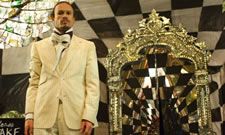
The Imaginarium Of Dr Parnassus
This week sees the release of The Imaginarium Of Doctor Parnassus, a film which, like several of Terry Gilliam's projects, very nearly never happened. This time the reason for that was particularly saddening - the death of Heath Ledger from an accidental overdose at the age of just 28. He and the director had been close personal friends and Gilliam, like everyone who knew the young actor, was heartbroken by his loss. But then he got a call from Johnny Depp, who wanted to commiserate with him, and who also pledged that he would make himself available if Gilliam wanted to finish the film.
In the film, the titular Dr. Parnassus' daughter is fated to be handed over the Devil, and Ledger's character announces his determination to save her. In real life, Gilliam's own daughter Amy stepped in to insist that the film be finished in tribute to the star. An accomplished producer in her own right, she helped to get together Depp, Jude Law and Colin Farrell to make it work. Because the film takes place in a fantasy world, Ledger's character is able to pass through a series of magic mirrors which change his appearance, so he is played by each of these actors in turn. Because they are all friends and familiar with each other's styles, the transformations are convincing and Ledger's own work still has the opportunity to shine.
Heath Ledger is far from the only actor to have died part way through a production. Often films have to be abandoned because of it, as with Marilyn Monroe's Something's Got To Give, but in other cases producers and directors have come up with inventive ways to keep their projects alive.
Probably the most notorious of these was the legendary Ed Wood's solution to the loss of Bela Lugosi, his only real star, part way through the filming of Plan 9 From Outer Space. Unable to find a substitute who looked like the original actor, Wood had the replacement simply hold up his black cloak to conceal his face throughout the later scenes. Unfortunately this still wasn't convincing, as the new actor was almost a foot taller than Lugosi. Owing to a mismatch of voices, all the character's remaining dialogue was written out.
If done with care, this approach can be rather more successful. Few fans noticed the substitution of a double for Jean Harlow in Saratoga, though all the director did was to hide part of her face behind a hat and shoot her from a distance. Harlow, just 26, was still a big star when she died of renal failure, and Saratoga went on to be a big success. When James Dean was killed in a car crash whilst making Giant, his scenes had been completed but there were problems with the sound, so Nick Adams stepped in to imitate his voice. Giant was also a big hit and was what really secured Dean's place as a legendary star.
The Poltergeist series suffered a double blow when actress Dominique Dunne was murdered shortly after the completion of the first film, so that her character had to be written out of the sequel, and child star Heather O'Rourke died of a heart attack during re-shoots for the third film. The latter project was completed using a double due to the poor quality of the existing material and the personal distress remaining cast and crew members felt when watching it, but the series never recovered, having lost its most charismatic star.
Brandon Lee's accidental death on the set of The Crow, eight days before filming was due to be completed, almost led to that film being abandoned, but his mother and fiancée prevailed upon the crew to finish it. The film itself focused on a young man reborn after being killed, and it was during this character's death scene that the actor was accidentally shot. Subsequently some scenes were filmed using a double, concealing his face where it made sense to do so and digitally superimposing Lee's face when necessary. Though this represented an early use of the technology, it's actually quite hard to identify the 'faked' scenes if you don't know where they are.
Since then, digital technology has improved considerably. Oliver Reed's fatal heart attack during the filming of Gladiator led to some of his scenes being cut back, but clever use of CGI filled in the gaps and meant it wasn't necessary to reshoot his scenes with another actor, thus enabling fans to enjoy his enthusiastic final performance.
In Sky Captain And The World Of Tomorrow, things went a step further. Sir Laurence Olivier appeared in the film despite being dead long before it was conceived. This harked back to the 1982 Steve Martin comedy Dead Men Don't Wear Plaid, which used archive footage to incorporate stars like Humphrey Bogart, Ingrid Bergman and Veronica Lake, but improved techniques meant that Olivier could appear in the same shots as other actors and really give the impression of doing something new. Some people in the industry have speculated that digital renderings based on existing footage could lead to a host of dead stars returning to perform in new roles in future films. Many may find the idea ghoulish, but there's no doubt that some of them would have been pleased by the notion that, on the silver screen, one can never truly die.





















